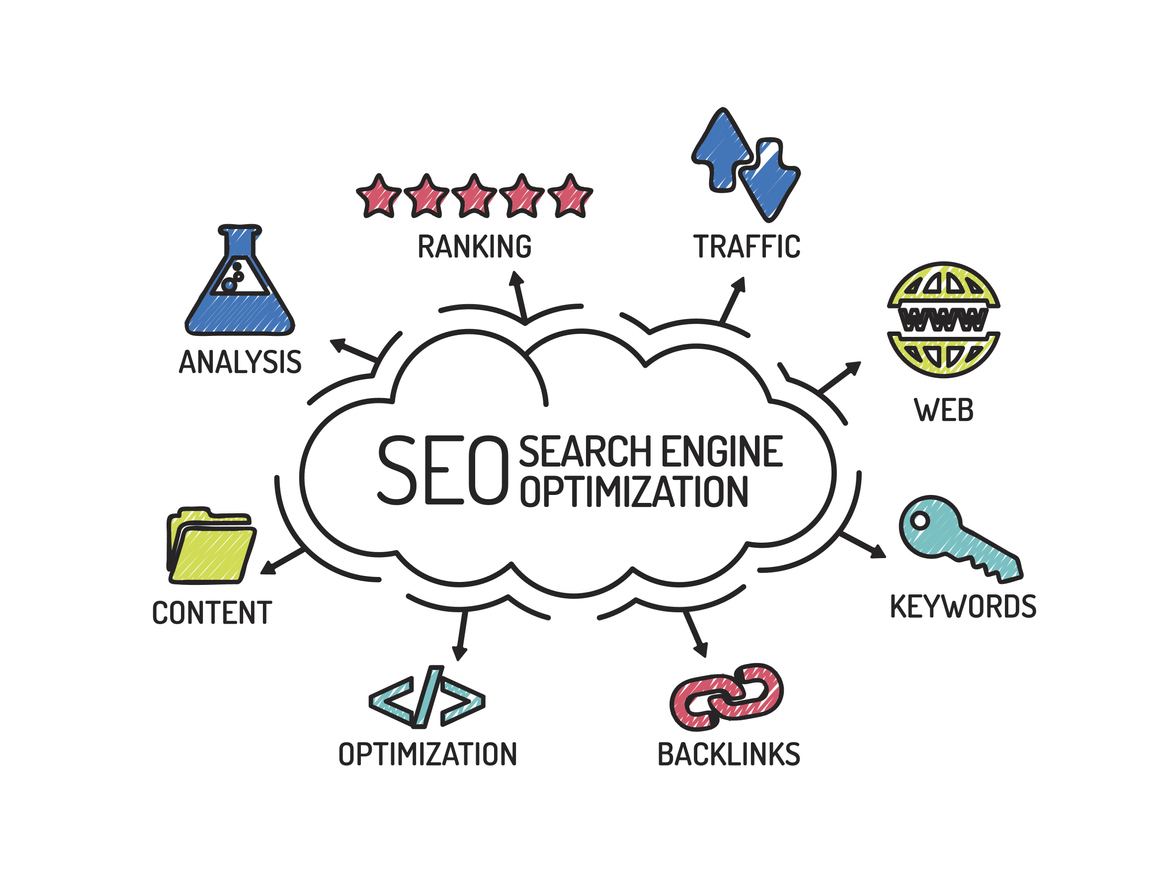Table of Contents
Are you interested in learning SEO but need help determining where to begin? Learn all you need to know about search engine optimization by reading our comprehensive guide for novices!
Most individuals try to avoid using the dreaded three-letter abbreviation “SEO.”
But when you take it apart, it’s not that awful. For instance, you may anticipate the following advantages when you design and manage a website that is user- and search-engine-friendly:
- Your website will receive more relevant traffic as you answer people’s search enquiries.
- Optimised search engine positioning as a result of greater content generation.
- Exposure and credibility will increase as more people get acquainted with, like, and trust your brand.
What is SEO?
The method for driving organic search traffic to a website is called Search Engine Optimisation (SEO). It’s where you take action to boost your visibility and position in a search engine’s organic results.
How websites function
SEOs must, at the very least, have a fundamental grasp of the item they are optimising if search engine optimisation is the process of improving a website for search!
We describe the website’s development below, from domain name acquisition to a fully displayed state in a browser. The key rendering route, or the process by which a browser transforms a website’s code into a visible page, is a significant part of the trip of a website.
For several reasons, SEOs should be aware of this information on websites:
- The procedures used to create a webpage can impact how quickly it loads, and Google considers speed when determining how to rank a site.
- Some resources, like JavaScript, are rendered by Google on a “second pass.” When SEO-important components are added to the website using JavaScript, they won’t be indexed since Google will first look at the page without JavaScript before rendering JavaScript a few days to a few weeks afterwards.
Types of SEO Services
On-page SEO:
The on-page approach focuses on getting your website’s content and codes more search engine friendly. This covers things like meta description and title tag optimisation and keyword research.
Off-page SEO
Aims to increase the number of high-quality websites linking to your website. Building high-quality backlinks will help you raise the ranking of your website because backlinks are one of the key ranking variables used by Google.
Technical SEO
Focuses on ensuring that your website is technically sound and that search engines can crawl and index it. Among other things, this entails making sure your website is error-free, mobile-friendly, and connected securely over HTTPS.
Content SEO
The practice of improving your website’s content with keyword research to be more search engine friendly is known as content SEO.
Local SEO
A digital marketing tactic called local SEO makes it possible for businesses to stand out more in the listings for local searches. Claiming your Google My Business page, optimising your website for local keywords, and establishing local citations are some examples of what this entails. Local SEO is crucial for businesses to draw in people looking for local companies. Your business’s exposure may be increased, and you can draw in more clients by optimising your website for local searches.
The function of content in SEO
Links would be useless if they didn’t point to searchers. Content is anything searchers consume, including text, images, and videos. If search engines are question-and-answer computers, the content is how the engines provide those answers.
How do search engines choose which sites the searcher would find helpful out of the hundreds of results that might be returned from a single query? How closely the content on your website fits the query’s purpose will play a significant role in where your page will rank for a particular question. Does this website, in other words, include the search terms and further the goal the user was seeking to achieve?
There are no hard rules on how long your content should be, how many times it should contain a keyword, or what you should write in your header tags because the emphasis is on user happiness and job completion. Those factors may affect how well a website performs in search, but the users reading the content should come first.
The Crawling, Indexing, and Ranking of Search Engines
These exist to find, understand, and organise online data to provide searchers with the most pertinent answers to their inquiries.
Your material must first be exposed to search engines to appear in search results. If your website can’t be found, there’s no chance you’ll ever appear in the SERPs (Search Engine Results Page). It’s undoubtedly the most crucial component of the SEO jigsaw.
How are search engines operating?
Search engines operate by performing three main tasks:
- Crawling: Search the Internet for content, examining each URL’s code and content.
- Indexing: Arrange and store the information gathered throughout the crawling process. Once a page is indexed, it has a chance of being returned as a response to pertinent searches.
- Ranking: Results are ranked from most relevant to least relevant to deliver the material that best satisfies a searcher’s inquiry.
What is search engine crawling?
Search engines send out a group of robots, called crawlers, as part of the discovery process to look for new and updated material. Links don’t matter what format the material is in – a webpage, an image, a video, a PDF, etc. – allow users to find it.
How do search engines understand and save your pages?
The next step is to ensure your site can be indexed after confirming it has crawled. The search engine renders a page once a crawler locates it as a browser. The index of the file contains all of that data.
How do search engines rank URLs?
How do search engines ensure users who enter a query into the search field receive accurate results? That procedure is called ranking. Search engines utilise algorithms, a method for retrieving and ordering data from memory, to identify relevance.
Search Engines’ Purpose
The goal of search engines has always been to deliver relevant responses to users’ queries in the most helpful manner. If that’s the case, why does it seem like SEO has changed from earlier years?

Consider how someone learning a new language might see it.
They initially have extremely basic language comprehension. They gradually build a deeper understanding and acquire semantics, studying language meaning and the connections between words and sentences. With enough practice, the learner eventually gains fluency in the language and can respond to even vague or incomplete queries.
It was far simpler to rig the system by utilising methods and tactics that go against quality requirements when search engines were only starting to grasp human language.
The Boon of SEO
Increased website traffic: If your website is SEO-optimised, it will appear in search results for relevant terms. This will result in more people visiting the website, which may generate more leads and sales.
Increased brand recognition: When your website appears in search results, this will increase your brand recognition. This is because if people see your website in the search results, they are more likely to remember it.
Enhanced Credibility: Search engines will give your website more credibility if optimised for SEO. This is due to search engines recognising your website’s authority and popularity.
Cost-effective: SEO is an inexpensive method of promoting your website. Without spending much money on advertising, you may anticipate results after using the appropriate SEO tactics.
Long-term advantages: Long-term SEO advantages are available. As long as you stay on top of the most recent SEO trends after optimising your website for SEO, you will continue to notice results.
Search for Keywords
Recognise the needs and interests of your audience.
After learning how to appear in search results, let’s now figure out which strategic keywords to target in the content of your website and how to write that material in a way that appeals to visitors and search engines alike.
Understanding your target market’s search habits and how they find your information, services, or goods is crucial to harnessing the potential of keyword research.
In this section, you’ll learn how to get that information using various tools and techniques, generate compelling content, and steer clear of common pitfalls in keyword research. The new world of strategic SEO opens once you learn how your target audience searches for your content.
Ask questions before doing keyword research.
Before using search engine optimization to help a business expand, you must first comprehend who the company is, its clients, and its objectives.
On this, compromises are frequently made. Because keyword research takes time, and you might already know what you want to rank for, only a few individuals skip this important planning phase.
The truth is that what your audience genuinely wants and what you want to rank for are frequently two completely different things. Campaigns that concentrate on your audience and then use keyword data to refine those insights will be considerably more effective than those focusing on random keywords.
Studying the SERP environment for the phrase you want to target to understand better searcher intent is crucial in the keyword research procedure. Look at the SERPs to find out what content your target audience prefers!
To deliver the most relevant material for each unique keyword search, Google has carefully examined the behaviour of billions of searches.
Authority for Link Building and Establishment
Boost the volume.
The fact that your content is what people are looking for to answer their problems and is understandable to search engines does not guarantee that it will rank. You need to develop authority to rank higher than the other websites with those characteristics. Earning connections from reputable websites, developing your brand, and cultivating an audience that will assist in spreading your material are all ways to do this.
What do links do?
Backlinks and Inbound links are terms used to describe HTML links that point from one website to another. The same rules apply to your website when using internal links or connections connecting internal pages of the same domain. As long as the internal linking is done properly and not in a spammy manner, a large number of internal links going to a certain page on your site will provide Google with a signal that the page is valuable.
The Function Links Serve in SEO.
There are two possible meanings when discussing linkages. Internal links are connections that refer to other pages, whereas backlinks are links from other websites that point to your website. Search engines understand your website is authoritative and relevant when they find links on other websites. This may raise your website’s position in search engine results pages (SERPs).
Internal links and external links are the two different categories of links. Internal links take visitors from one page of your website to another. External links are connections to your website made by other websites.
For SEO, both internal and external connections are crucial. Internal links assist search engines in crawling your website and comprehending its architecture. Your website’s authority and positioning in search engine results may both be improved with external links.
To summarise!
It is claimed that anything can be improved if it can be measured.
It’s the same with SEO. Professional SEOs analyse metrics that show the effectiveness of SEO, including rankings, conversion rates, lost links, and more. It’s crucial to your SEO effectiveness, customer retention, and the perceived value that you measure the effects of your work and continual improvement.
When something isn’t working, you can change your priorities.




